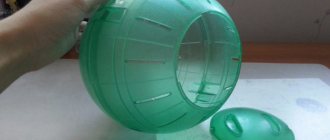Most pet rat owners end up faced with the emotionally painful and difficult decision to euthanize their beloved pet. All pet owners want to spend as much time as possible with their pet. However, the decision to euthanize must be made before the rat becomes distressed, giving the pet a chance to end its life in comfort.
The main rule is to never allow prolonged suffering. Understanding the idea that euthanasia is right, necessary, and the most compassionate and loving decision you could ever make for your rat can be much easier than deciding when it needs to be done.
When is it necessary to euthanize a rat?
This is always the most difficult decision for pet owners. Most people make the decision to euthanize their pet either too soon or too late. Rats are very resilient animals. Being at the bottom of the food chain in the wild, our pet rats have retained the ability to mask their symptoms for as long as possible to avoid being the “weakest” ones who are most often eaten.
However, you should not think that it is too late to do something about it and euthanasia is the only option. Even in cases of advanced respiratory disease (after a long chronic illness), when a rat begins to have asthma attacks, it can survive. There is a good chance, as long as the rat is still eating, drinking and active, that it will recover from the choking attack in a short time and continue its normal life, at least for a while. In such cases, daily doses of Prednisone help. However, when attacks begin every day, each time for longer periods, it is best to end the animal's suffering.
When is actually the right time to euthanize your beloved pet? This is when all medical alternatives have been tried to no avail and the rat is no longer enjoying its life. This is most often evidenced by a pet that is no longer active, stops eating, drinking, and generally appears unhappy. This does not mean that a pet that has just had surgery, suffered a painful injury, or is very ill should be euthanized if they are inactive and losing their appetite. The animal must be given time to recover before making this irreversible decision.
In what situations should you euthanize your hamster?
Euthanasia of a hamster is reasonable and permissible for conditions that cause suffering to the animal and have no chance of cure:
- various injuries in which the pet is physically unable to live actively: back injuries, traumatic brain injuries and bruises with serious injury to internal organs;
- diseases that do not have effective treatment and a favorable prognosis, most often these are malignant neoplasms characterized by metastases in various organs and severe pain;
- damage to the nervous system, manifested in aggressive behavior towards household members;
- advanced age of hamsters, accompanied by pain, loss of the ability to move and eat;
- congenital diseases in which the animal is doomed to death.
It should be remembered that only a veterinarian is able to diagnose a hamster’s condition that is incompatible with life, in which euthanasia is the only correct solution. In such cases, the owner’s duty is to alleviate the suffering, and not to kill the pet.
How to make a decision about euthanasia?
When a pet has a terminal illness and medical options for successful treatment are not available, it can be understood that euthanasia is the best option at this time. One of the most important parts of helping owners make these decisions is obtaining a definitive diagnosis of the rat's health. This important point eliminates doubt, reduces guilt, and provides the owner with a greater level of comfort when making future decisions to treat or not treat.
Establishing a diagnosis may involve proper examination, drug treatment, or surgical procedures. A diagnosis can make a big difference during this difficult time. Some people just need a diagnosis to feel comfortable, while others don't want to continue watching their pet decline.
The rat should take pain medication daily if necessary and medically appropriate to ensure maximum comfort until the time comes. Your veterinarian may have several options depending on your pet's illness and condition.
Cremation
Cremation is the burning of biological remains in ovens. At high temperatures, even from large bodies no more than 10% remains.
The resulting ashes are sterile, so they can be stored even in an ordinary apartment.
Cremation is carried out by special enterprises - crematoria. They operate in industrial areas, far from urban settlements.
Our clinic delivers deceased rodents to leading crematoria in Moscow and the Moscow region, where, at the request of the owners, general or individual cremation is performed.
In the first case, it is impossible to isolate the ashes of the animal, since several bodies are placed in the oven at once.
In the second, only one pet is burned, so its remains are handed over to the owner.
How is euthanasia carried out?
There are many different methods of euthanasia, but very few are suitable for use with rats. Many veterinarians do not even realize that some methods are inhumane. Of course, most pet owners don't think about this aspect of euthanasia and will leave their pet in the hands of a veterinarian, trusting him to perform the procedure in a humane manner.
The usual method used for dogs and cats is to inject the euthanasia drug directly into a vein, but this cannot be done in rats or mice due to their size. It is impossible to find a vein large enough to inject, so the injection is given either directly into the heart or into the abdominal cavity (belly). Both of these injections are extremely painful.
Yes, it is true that in most cases the pet will simply fall asleep and die within a few minutes, but do you really want your pet to have to go through that painful injection at the last minute when it is not necessary?
It is important to insist that your pet be anesthetized using inhalational anesthesia before any lethal injections are given. A lethal injection may not even be necessary if the rat is overdosed on anesthesia.
Urns for ashes
If the choice was made in favor of cremation, you will need an airtight, durable and beautiful urn for the ashes.
This product is specific, and you can’t buy it everywhere. To avoid wasting time searching, order an urn from our veterinary clinic.
We offer different options - ceramic, glass, metal, we apply engraving, a photo of your pet.
In a high-quality container, the ashes will be stored reliably for a long time.
The urns are durable, difficult to break, but they look original and will fit into the interior of the room.
General services
| Prices for services in our clinic | In the clinic and at home |
| Ratologist visiting your home | from 500 |
| Clinical examination, preliminary diagnosis, consultation | from 500 |
| Telephone consultation | for free |
| Therapy | from 150 |
| Surgery | from 150 |
| Ambulance at home (within an hour) | from 1000 |
Therapy
| Prices for services in our clinic | In the clinic and at home |
| Subcutaneous administration of drugs to rodents | from 150 |
| Intramuscular administration of drugs to rodents | from 200 |
| Intravenous (into a catheter, through a needle) | from 200 |
| Dropper for rodents | from 1000 |
| Placement of an intravenous catheter | from 300 |
| Removing the IV catheter | 200 |
| Tube feeding of rodents | from 300 |
| Taking blood samples | from 300 |
| Novocaine blockade | from 200 |
| Reduction of the cheek pouch | from 200 |
| A haircut | |
| Nail trimming | from 300 |
| Haircutting mats | from 1000 |
| Ear treatment | from 300 |
Surgery and Traumatology
| Prices for services in our clinic | In the clinic and at home |
| Surgery | |
| Surgery of the genitourinary organs in rodents: | |
| Castration | from 2000 |
| Sterilization | from 2500 |
| Surgical procedures | from 400 |
| Surgical treatment of wounds | from 300 |
| Application of musculocutaneous sutures | from 200 |
| Applying a bandage | from 100 |
| Applying a plaster cast | from 1000 |
| Removing the plaster cast | from 300 |
| Surgery for skin, soft tissue and tumor infections | |
| Opening abscesses, hematomas | from 400 |
| Treatment of purulent wounds | from 700 |
| Drainage installation | from 500 |
| Flushing the drainage | 350 |
| Treatment of auricular hematoma | from 1500 |
| Unilateral mastectomy | from 4000 |
| Regional mastectomy | from 5000 |
| Removal of tumors | from 2000 |
| Abdominal surgery | |
| Obstetrics in rodents | from 1000 |
| Animation of newborns | from 300 |
| C-section | from 3000 |
| Pyometra | from 1500 |
Anesthesiology for rodents
| Prices for services in our clinic | In the clinic and at home |
| Anesthesia | from 500 |
Ophthalmology
| Prices for services in our clinic | In the clinic and at home |
| Eyelid surgery for inversion, eversion | from 2000 |
| Exenteration of the eyeball | from 3000 |
Dentistry
| Prices for services in our clinic | In the clinic and at home |
| Removal of incisors | from 500 |
| Trimming and correction of teeth in rodents | from 1500 |
Laboratory diagnostics
| Prices for services in our clinic | In the clinic and at home |
| Blood analysis: | |
| General clinical blood test | 900 |
| Blood cytology | 1000 |
| Biochemical analysis for 1 sample indicator | 300 |
| Biochemical blood test for 6 indicators | 1500 |
| Biochemical blood test for 12 indicators | 2500 |
| Additional biochemical indicators for pancreatic amylase, rheumatoid factor, c-reactive protein | from 300 |
| Analysis of urine: | |
| General clinical urine analysis | 400 |
| Express urine glucose test | 200 |
| Express urine test | 300 |
| Biochemistry of urine 1 indicator | 100 |
| Stool examinations | |
| General stool analysis | 500 |
| Stool culture for pathogens | 1500 |
| Stool analysis for dysbacteriosis | 2000 |
| Stool analysis for protozoa and helminth eggs | 500 |
| Bacteriology | |
| Bacteriological screening | 2000 |
| Microbiological screening | 2000 |
| Full microbiological screening (no subtitration) | 1500 |
| Skin studies | |
| Skin biopsy | 1700 |
| Skin smear | 1000 |
| Dermatophytes and ectoparasites | 1000 |
| Pathomorphology | 1500 |
| Histology of neoplasms, cystic contents | 2000 |
| Cytology of neoplasms, cystic contents | 1500 |
Euthanasia at home
Home euthanasia will allow the owner to be with their pet in the last minutes of its life. This ensures that the rat does not have to suffer while waiting for the veterinarian to perform the procedure. Also, the animal will not have to experience anxiety or stress in the last minutes of life due to a trip to the veterinary clinic.
However, it is not recommended to consider euthanizing a pet at home using any method other than an overdose of anesthesia. This is the only humane method. Let's find out more about this procedure.
When the time comes, you will need to do the following:
- Take a soft rat towel and wrap the animal in it.
- Pour some Halothane onto a couple of cotton balls and place them in a small jar.
- Place the jar in front of the rat's nose.
Halothane is not unpleasant, but the rat will usually move away from the jar first. The animal will stick its nose into the jar and after a short time will simply fall asleep. Slowly and without fear, the animal dies.
The decision to end an animal's life is never easy. But you can rest easy knowing that your pet did not have to suffer and was surrounded by love in its final moments.
Recommendations and tips
Here are some guidelines to follow when making this difficult decision:
- Fix the problem
. Before making any decisions, get an accurate diagnosis from your rat veterinarian. There may be a simple solution to your pet's health problem. - Separate the sick rat from the rest of your pets.
This will not only help prevent the spread of any possible disease, but will also make the environment more comfortable for the animal. - Clean and sterilize your pet's living space.
It is possible that a contaminated home has a negative effect on the rat. Clean and disinfect the cage thoroughly. Replace all bedding and food. Change the water. See if this affects your pet's health and behavior. - Keep the rat in a quiet place.
Don't keep your rodent in the busiest part of the house. Keeping your pet in a quiet place will help relieve stress, which is critical to their health. Don't let children bang on the cage or disturb his sleep. - Limit handling of your pet
. If your pet is sick, do not move him unnecessarily or pick him up to play. Emphasize the importance of this to all children in the home. - Consider your pet's age.
Young rats have a much better chance of bouncing back and recovering from illness. Older rats are less resistant to disease and are often weaker. - Discuss your options with your veterinarian.
Your pet's veterinarian can provide an accurate diagnosis and prognosis regarding your pet's health. Ask about all treatment options and discuss euthanasia methods for your pet. If necessary, carry out the procedure yourself.
Burial
Leaving a dead pet on the street, in a park or near a river means breaking the law, and if caught, even getting a fine.
Russian legislation allows the burial of domestic animals only in areas permitted for this purpose.
All of them are located outside the city limits to prevent the spread of dangerous infections.
Our veterinary hospital works under an agreement with large cemeteries for pets, providing assistance with delivery and burial.
We offer convenient work hours for employees who can pick up a rodent at any time of the day, as well as favorable prices for ritual assistance.











